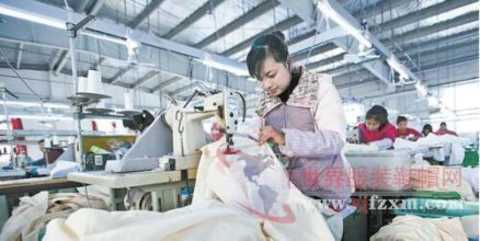In October, the textile and apparel trade volume was US$23.24 billion, down 9.1%, of which exports were US$21.43 billion, down 9.4%, and imports were US$1.81 billion, down 5.2%. The trade surplus for the month was US$19.62 billion, down 9.8%. From January to October, the textile and apparel trade volume was US$241.36 billion, down 5.9%, of which exports were US$222.29 billion, down 5.4%, imports were US$19.07 billion, down 10.9%, and the accumulated trade surplus was US$203.22 billion, down 4.9%. First, the price decline caused the export to continue to grow negatively Although the recent appreciation of the US dollar against the renminbi is conducive to exports, the price of commodities denominated in US dollars has declined. The export prices of key commodities have declined to varying degrees. The export price index fell 9.2% in the month, and the export volume index was basically the same as that of the same period last year. Slightly decreased. The decline in imports was due to the double decline in both quantity and price. Second, the general trade and processing trade exports are now double-digit decline, market purchases continue to grow Exports of major trade methods continued to decline in October, and the declines reached double digits. Exports of general trade and processing trade fell by 10.2% and 20.9% respectively. Other trade patterns dominated by market purchases were the only way to effectively shape exports, which increased by 47.9%. From January to October, exports of general trade and processing trade fell by 4.8% and 17.4% respectively; market purchases increased by 31.6%, and the proportion rose further to 5.9%. Third, exports have declined, and the overall performance of major markets has been poor. EU - exports to the EU continued to decline by 2 digits, and clothing exports declined. Exports to the EU continued to show double-digit decline in October, with exports of 3.31 billion US dollars, down 12.4%, of which textiles fell 4.1%, clothing fell to 15.1%, and only less than 2 months during the year. Exports fell by 6%, and average export prices fell by 9%. From January to October, the cumulative export to the EU was US$41.33 billion, down 6.1%, of which textiles increased by 1.4%, clothing decreased by 8.3%, total exports of needle woven garments increased by 0.2%, and export unit price fell by 9%. The United States - exports to the United States have stabilized and stabilized. Exports to the United States have been negative for seven consecutive months, and exports in October were $3.67 billion, down 6.1%. Among them, the export volume of large-sized commodity needle woven garments decreased by 3.9%, and the export unit price fell by 3.7%. Although it has not yet got rid of the decline, the decline in exports to the United States has gradually narrowed, staying within 10% for four consecutive months, and there has not been a continuous double-digit decline in other key markets, and the market is relatively stable. From January to October, the cumulative export to the United States was 37.81 billion US dollars, down 6.2%, of which textiles fell 5.1% and clothing fell 6.6%. The export volume of needle woven garments decreased by 2.8%, and the average unit price of exports fell by 2.6%. The growth of ASEAN-textile exports has made the ASEAN market slightly stable. Although exports to ASEAN fell by 10.2% year-on-year in October, the export volume rebounded from the previous period. The export volume of the month was 2.87 billion US dollars, exceeding the average of the third quarter. The market is slightly stable. Among them, mainly driven by a 2.5% increase in textiles, clothing fell by 33.5%. Among the large categories of goods, yarns and fabrics increased by 4.4% and 2.9% respectively, and the export volume of needle woven garments decreased by 9%. The decline in the export prices of large categories of goods further expanded, with yarns falling by 5.7%, fabrics falling by 11.5%, and needle woven garments falling by 27.8%. From January to October, the cumulative export to ASEAN was US$27.35 billion, down 4.5%, of which textiles increased by 2.8% and clothing decreased by 19.6%. Among them, the export volume of needle woven garments decreased by 5%, and the average unit price of exports fell by 16.5%. Exports to the Philippines resumed growth, growing by 24.4% in October and a cumulative increase of 45.3% from January to October. Japan - Exports to Japan have fallen sharply, and the volume of clothing exports has fallen. Exports to Japan have been negative for two consecutive months, down 12.5% ​​in October, and the decline has exceeded other major markets. The key commodity clothing decreased by 14.6%, of which the total export volume of needle woven garments decreased by 6.3%, and the export unit price decreased by 8%. From January to October, the cumulative export to Japan was 17.03 billion US dollars, down 5.8%. Among them, textiles decreased by 2.1%, clothing decreased by 6.8%, needle woven garments decreased by 1.2%, and export average unit price decreased by 5.3%. According to Japanese customs statistics, the share of Chinese products in Japan fell to 61.6% from January to September, and the proportion of imports from ASEAN rose to 23.1%. Fourth, the export prices of large categories of goods generally fell After a brief rapid decline in September, textile exports rebounded slightly in October, and the decline narrowed to 6.7% in the month, with yarns, fabrics and finished products down 5.6%, 8.4% and 4.7% respectively. The total export volume of needle woven garments in garments decreased by 2.4%. The unit price of large-scale merchandise exports generally fell: the unit price of yarn fell to the lowest in the year, down 9.4% and 5.7% respectively, while fabrics fell 9.3%, and needle woven garments fell 9.7%, both falling nearly 10%. From January to October, exports of textiles and garments decreased by 3.3% and 6.8%, respectively. Among them, yarns and fabrics decreased by 1.7% and 3.7% respectively. The export volume of needle-woven garments decreased by 0.5%. The unit prices of three major categories of goods fell by 13%. , 8.1%, 6.5%. 5. Shandong and Fujian have double-digit exports in the month, and Hunan and Sichuan have grown rapidly. In October, the exports of major provinces and cities all declined. The decline in Zhejiang was smaller than that of the previous month, but it still reached 9.9%. Shandong fell by 18.6%, the largest monthly decline in the year; Fujian fell by 17.2%, and the second consecutive month showed a double-digit decline. . The declines in Jiangsu and Guangdong were slightly slower, both less than 5%. Exports in some central and western regions have grown rapidly. Xinjiang's exports have increased by more than 10% for three consecutive months. Since July, Hunan's export growth has expanded month by month, with an increase of 174% in October. Sichuan's growth in September and October has more than doubled. From January to October, only 8 provinces and municipalities in the country achieved export growth, most of which were in the central and western regions. In the eastern provinces, only Shandong grew by 0.3%, while Zhejiang and Fujian fell by 6.4% and 7.3%, respectively, exceeding the average decline. Sixth, clothing imports slowed down, commodity prices rebounded In October, textile imports fell by 8.3% and clothing increased by 4.4%. The yarns in the textiles decreased by 12.4%, of which the cotton yarn imports and values ​​decreased by 19.3% and 15% respectively. The import volume and growth of garments both slowed down. The total imports of needles and woven garments totaled 41.98 million pieces (sets), which was the lowest in the year, down 0.7% year-on-year. Commodity import prices rose, yarns rose 5%, and needle woven garments rose 2.7%. From January to October, the cumulative import of textiles decreased by 15.1%, and clothing increased by 1.6%. Yarns, fabrics and finished products in textiles decreased by 21.8%, 11.5% and 4.9% respectively. In the clothing, the total import volume of needle woven garments increased by 6.3%, and the unit price of imports decreased by 3.7%. 7. The import volume of cotton fell, and the spread of cotton between domestic and foreign cotton expanded. Imports of cotton continued to fall in October, importing only 41,000 tons in the month, down 1.8% year-on-year, and the unit price of imports continued to rise, up 6.3% year-on-year. From January to October, the cumulative import volume was 698,000 tons, a decrease of 42%, and the unit price of imports fell by 1.8%. In October, the new cotton harvest entered a peak period, and the number of cotton companies acquired in the market increased. However, the acquisition progress was slower than last year. At the beginning of the month, the purchase price of seed cotton was higher and stabilized in the middle. The textile market trend was less than expected, while the price of new cotton remained at a high level. Textile enterprises continued to use cotton stocks in the previous period. After the release of reserve cotton, the market focus turned to new cotton prices. As the seed cotton purchase market opened higher and higher, the spot price of new cotton also rose. China's cotton price index (CCIndex3128B) was 14,866 yuan / ton at the end of the month, up 492 yuan / ton from the end of last month, an increase of 3.3%. The average monthly transaction price was 15,315 yuan / ton, up 1057 yuan / ton, up 2,274 yuan / ton. The international cotton market was affected by the new cotton market, the fluctuation of the US dollar index and the UASA report. The spot cotton price fluctuated and the overall monthly average price fluctuated little. However, due to the rise in domestic prices, the price difference between domestic and foreign cotton has expanded significantly. China's imported cotton price index FCIndexM averaged 79.32 cents per lb, up 0.06 cents from the previous month, and 1% tariff was reduced to RMB 13520/ton, lower than the Chinese cotton price index of 1843 yuan/ton in the same period, which was 959 more than the previous month. yuan. The sliding standard tax will be reduced to RMB 15016/ton, which is lower than the Chinese cotton price index of RMB 347/ton in the same period (last month was higher than the China Cotton Price Index by RMB 668). Women'S Fitness Yoga Wear,Women'S Seamless Yoga Wear,Women'S Yoga Wear,High Stretchy Yoga Wear Shaoxing Yizhong Textile And Garment Co.,Ltd , https://www.yizhongsport.com

